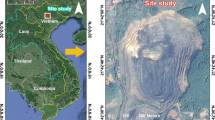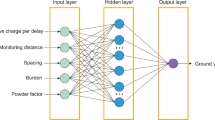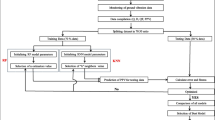Abstract
Formulating a predictive model for blast-induced ground vibration (BIGV) has always been challenging due to the complex non-linear relationship between the BIGV and its influencing factors. Researchers have used empirical, artificial intelligence methods and numerical modelling methods to predict BIGV. In a dragline bench blasting, a massive quantity of explosives is used compared to other loading machinery, and the height of the bench depends on the size of the dragline. For effective utilization of explosives energy, decking is used to reduce the hazardous effects of blasting. In this paper, an attempt has been made for effective prediction of BIGV, and its mitigation on dragline bench blasting considering a deck length, stiffness ratio, hole spacing to burden ratio, hole depth to burden ratio, the distance of monitoring PPV from blasting site, Schmidt hammer rebound number of the bench to be blasted, and maximum charge per hole to total charge per blast. So artificial neural network (ANN) model and random forest (RF) model have been developed considering the parameters mentioned above. For the statistical performance of the predictive model, the coefficient of determination (R2) value is 0.8895, MSE is 22.84 for the ANN model, and the random forest (RF) model whose R2 is 0.8165 and MSE is 27.18. The sensitivity analysis results show that stiffness ratio, deck length, and Schmidt hammer rebound number are more influential parameters out of the selected parameters. The reduction of ground vibration with the introduction of decking led to a 3 to 15% reduction in ground vibration.








Similar content being viewed by others
References
Singh PK, Roy MP, Sinha A (2008) Study on the impact of opencast blasting on surrounding structures in environmentally sensitive areas. Gospod Surowcami Miner 24
Kumar S, Choudhary BS (2019) Prediction of blast-induced ground vibration by ANN, USBM and CMRI formulae for safety of the structures near surface coal mines. J Mines Met Fuels 67(7)
Kumar S, Mishra AK, Choudhary BS (2023) Estimation equations for back break and ground vibration using genetic programming. Geotech Geol Eng 41(5):3139–3149
Kumar S, Choudhary BS (2019) Prediction of blast-induced ground vibration by ANN, USBM and CMRI formulae for safety of the structures near surface coal mines. J Mines Met Fuels 67(7):351–356
Kumar S, Singh B, Arvind C, Mishra K (2021) Modelling the effects of ground vibrations on the surface due to blasting in underground coal mines. Nat Hazards 0123456789
Kumar S, Mishra AK, Choudhary BS (2017) Study of P and S wave velocity of rocks in Jharia coalfield region for assessment of its geotechnical properties in dry, semi-saturated and saturated conditions. Ann Chim – Sci Des Matériaux 0151-9107 4/13–4(3–4):209–223
Hasanipanah M, Faradonbeh RS, Amnieh HB, Armaghani DJ, Monjezi M (2017) Forecasting blast-induced ground vibration developing a CART model. Eng Comput 33(2):307–316
Saghatforoush A, Monjezi M, Faradonbeh RS, Armaghani DJ (2016) Combination of neural network and ant colony optimization algorithms for prediction and optimization of flyrock and back-break induced by blasting. Eng Comput 32(2):255–266
Hajihassani M, Armaghani DJ, Marto A, Mohamad ET (2015) Ground vibration prediction in quarry blasting through an artificial neural network optimized by imperialist competitive algorithm. Bull Eng Geol Environ 74(3):873–886
Ebrahimi E, Monjezi M, Khalesi MR, Armaghani DJ (2016) Prediction and optimization of back-break and rock fragmentation using an artificial neural network and a bee colony algorithm. Bull Eng Geol Environ 75(1):27–36
Garai D, Mishra AK, Kumar S, Agrawal H 2018 Development of a universal blast-induced ground vibration prediction model for Jharia coalfields. Model Meas Control C 79(2)
Dou Y (2020) A method to remove depositional background data based on the modified Kernel Hebbian algorithm. Acta Geophys 68(3):701–710
Signatures M, Yang Y, Hou C, Lang Y, Sakamoto T, Member S (2020) Omnidirectional motion classification with monostatic radar system using. IEEE Trans Geosci Remote Sens 58(5):3574–3587
Li Y, Ren X, Zhao T, Xiao D, Liu K, Fang D (2021) Dynamic response of stiffened plate under internal blast: experimental and numerical investigation. Mar Struct 77:102957
Wang P, Wang L, Leung H (2021) Super-resolution mapping based on spatial – spectral correlation for spectral imagery 59(3):2256–2268
Wei H, Chen J, Zhu J, Yang X, Chu H (2020) A novel algorithm of Nested-ELM for predicting blasting vibration. Eng Comput 0123456789
Monjezi M, Ghafurikalajahi M, Bahrami A (2011) Prediction of blast-induced ground vibration using artificial neural networks. Tunn Undergr Sp Technol Inc Trenchless Technol Res 26(1):46–50
Nguyen H, Drebenstedt C, Bui X-N, Bui DT (2020) Prediction of blast-induced ground vibration in an open-pit mine by a novel hybrid model based on clustering and artificial neural network. Nat Resour Res 29(2):691–709
Nguyen H, Bui X-N, Tran Q-H, Moayedi H (2019) Predicting blast-induced peak particle velocity using BGAMs, ANN and SVM: a case study at the Nui Beo open-pit coal mine in Vietnam. Environ Earth Sci 78(15):479
Boswell D (2002) Introduction to Support Vector Machines 1–15
Khandelwal M (2011) Blast-induced ground vibration prediction using support vector machine. Eng Comput 27(3):193–200
ShiraniFaradonbeh R et al (2016) Prediction of ground vibration due to quarry blasting based on gene expression programming: a new model for peak particle velocity prediction. Int J Environ Sci Technol 13(6):1453–1464
Hasanipanah M, BakhshandehAmnieh H, Khamesi H, JahedArmaghani D, BagheriGolzar S, Shahnazar A (2018) Prediction of an environmental issue of mine blasting: an imperialistic competitive algorithm-based fuzzy system. Int J Environ Sci Technol 15(3):551–560
Algorithm G (2017) Improved prediction of blast-induced vibrations in limestone mines using genetic algorithm 8(2):291–304
ShiraniFaradonbeh R, Monjezi M, JahedArmaghani D (2016) Genetic programing and non-linear multiple regression techniques to predict backbreak in blasting operation. Eng Comput 32(1):123–133
Hajihassani M, Armaghani DJ, Sohaei H, Mohamad ET, Marto A (2014) Prediction of airblast-overpressure induced by blasting using a hybrid artificial neural network and particle swarm optimization. Appl Acoust 80:57–67
AminShokravi A, Eskandar H, Derakhsh AM, Rad HN, Ghanadi A (2018) The potential application of particle swarm optimization algorithm for forecasting the air-overpressure induced by mine blasting. Eng Comput 34(2):277–285
Hasanipanah M, Naderi R, Kashir J, Noorani SA, Qaleh AZA (2017) Prediction of blast-produced ground vibration using particle swarm optimization. Eng Comput 33(2):173–179
Ghasemi E, Kalhori H, Bagherpour R (2016) A new hybrid ANFIS–PSO model for prediction of peak particle velocity due to bench blasting. Eng Comput 32(4):607–614
Arthur CK, Temeng VA, Ziggah YY (2020) Novel approach to predicting blast-induced ground vibration using Gaussian process regression. Eng Comput 36(1):29–42
Zhang Y-N, Xiao X-C, Chen Y-W (2010) Number determination of hidden-layer nodes for Hermite feed-forward neural network. J Zhejiang Univ Eng Sci 44(2):271–275
Longjun D, Xibing L, Ming X, Qiyue L (2011) Comparisons of random forest and support vector machine for predicting blasting vibration characteristic parameters. Procedia Eng 26:1772–1781
Kumar S, Mishra AK, Choudhary BS, Sinha RK, Deepak D, Agrawal H (2020) “Prediction of ground vibration induced due to single hole blast using explicit dynamics. Min Metall Explor 37(2):733–741
Taheri K, Hasanipanah M, Golzar SB, Majid MZA (2017) A hybrid artificial bee colony algorithm-artificial neural network for forecasting the blast-produced ground vibration. Eng Comput 33(3):689–700
Jhanwar JC (2011) Theory and practice of air-deck blasting in minesand surface excavations: a review. Geotech Geol Eng 29(29):651–663
Liu L, Katsabanis DP (2020) Numerical modelling of the effects of air decking/decoupling in production and controlled blasting. In: Rock Fragmentation by Blasting, CRC Press, pp 319–330
Jhanwar JC, Cakraborty AK, Anireddy HN, Jethwa JL (1999) Application of air decks in production blasting to improve fragmentation and economics of an open pit mine. Geotech Geol Eng 17(1):37–57
Kabwe E (2017) Improving collar zone fragmentation by top air-deck blasting technique. Geotech Geol Eng 35(1):157–167
Jhanwar JC, Jethwa JL, Reddy AH (2000) Influence of air-deck blasting on fragmentation in jointed rocks in an open-pit manganese mine 57:13–29
Hayat MB, Alagha L, Ali D (2019) Air decks in surface blasting operations 55(6):922–929
Pradhan M, Balakrishnan V, Pradhan GK (2015) Use of discarded water bottles in blasting- an innovative enviro-friendly technique 3(1):51–56
Cheng R, Zhou Z, Chen W, Hao H (2022) Effects of axial air deck on blast-induced ground vibration. Rock Mech Rock Eng 55(2):1037–1053
Park D, Jeon S (2010) Reduction of blast-induced vibration in the direction of tunneling using an air-deck at the bottom of a blasthole. Int J Rock Mech Min Sci 47(5):752–761
Khandelwal M, Singh TN (2007) Evaluation of blast-induced ground vibration predictors. Soil Dyn Earthq Eng 27(2):116–125
Ljung L (1995) System identification toolbox: user’s guide. Citeseer
Youssef AM, Pourghasemi HR, Pourtaghi ZS, Al-Katheeri MM (2016) Landslide susceptibility mapping using random forest, boosted regression tree, classification and regression tree, and general linear models and comparison of their performance at Wadi Tayyah Basin, Asir Region, Saudi Arabia. Landslides 13(5):839–856
Kumar S, Mishra AK, Choudhary BS (2021) Prediction of back break in blasting using random decision trees. Eng Comput 1–7
Rodriguez-Galiano V, Sanchez-Castillo M, Chica-Olmo M, Chica-Rivas M (2015) Machine learning predictive models for mineral prospectivity: an evaluation of neural networks, random forest, regression trees and support vector machines. Ore Geol Rev 71:804–818
Monjezi M, Rezaei M, Yazdian A (2010) Prediction of backbreak in open-pit blasting using fuzzy set theory. Expert Syst Appl 37(3):2637–2643
Author information
Authors and Affiliations
Corresponding author
Ethics declarations
Conflict of Interest
The authors declare no competing interests.
Additional information
Publisher's Note
Springer Nature remains neutral with regard to jurisdictional claims in published maps and institutional affiliations.
Rights and permissions
Springer Nature or its licensor (e.g. a society or other partner) holds exclusive rights to this article under a publishing agreement with the author(s) or other rightsholder(s); author self-archiving of the accepted manuscript version of this article is solely governed by the terms of such publishing agreement and applicable law.
About this article
Cite this article
Singh, C.P., Kumar, S. & Mishra, A.K. Effect of Deck Length on Ground Vibration in Dragline Bench Blasting Using Artificial Intelligence Methods. Mining, Metallurgy & Exploration (2024). https://doi.org/10.1007/s42461-024-00996-2
Received:
Accepted:
Published:
DOI: https://doi.org/10.1007/s42461-024-00996-2




